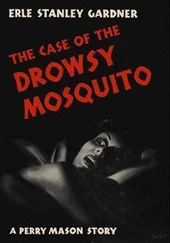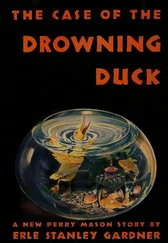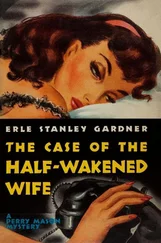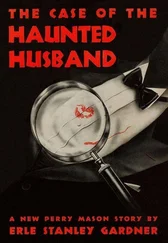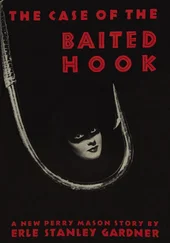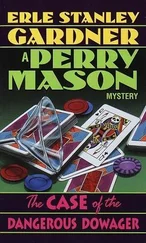“That was what I was there for.”
“That is not exactly an answer to the question,” Hamilton Burger pointed out. “Did you...”
“Yes, I did.”
“You noticed her particularly?”
“Yes, sir.”
“And you saw this woman emerge from room 721?”
“I did. Yes, sir.”
“Who was that woman?”
“Miss Dixie Dayton, one of the defendants in this case.”
“Will you please designate the woman.”
“The one I am pointing at.”
“The record doesn’t show the one that you’re pointing at. May I ask Miss Dayton, the defendant, to stand up?”
“Stand up,” Mason said.
Dixie Dayton stood up.
“Is that the woman?”
“That is the woman.”
“Let the record show,” Hamilton Burger said, “that the identification is that of the woman who stood up, and the woman who stood up is Dixie Dayton, one of the defendants in this case.
“What did you do when this woman left the room?” Burger asked.
“I followed her.”
“Where?”
“She took the elevator. The elevator went up. I ran up one flight of stairs. I was on the seventh floor, and there were only eight floors in the hotel. I therefore knew she couldn’t go up more than one floor. I felt that I could get up there almost as soon as the elevator.”
“And you did so?”
“Yes.”
“And where did this woman go?”
“She went to room 815, the room where the body of George Fayette was subsequently discovered by the police.”
“This same woman?” Burger asked.
“This same woman.”
“You’re positive?”
“Positive.”
“And who was that woman?”
“I have already told you.”
“I mean, who was the woman who went to this room 815?”
“The defendant, Dixie Dayton.”
“The same person who stood up? The same person you have previously identified?”
“Yes, sir.”
“Cross-examine,” Burger said to Perry Mason.
Minerva Hamlin turned to face Perry Mason with eyes that flashed antagonism, a manner that plainly showed she intended to give tit for tat, and that no adroit cross-examination was going to confuse her.
Mason’s attitude was that of an older brother asking an impulsive younger sister to confide in him.
“Miss Hamlin,” he said, “you didn’t know Dixie Dayton, did you?”
“I had never seen her until she stepped out of that room.”
“You didn’t know who she was at the time?”
“I saw her, I didn’t know her name, no.”
“And the police showed you a photograph of Dixie Dayton and asked you if that was the same woman, didn’t they?”
“Yes.”
“What did you tell them?”
“I told them it was.”
“Didn’t you tell them that you thought it looked like the same woman?”
“Well, if it was the same woman it would look like her, wouldn’t it?”
There was a ripple of merriment in the courtroom at her tart rejoinder.
“That,” Mason said, “is quite true. Since you ask me the question I’ll be only too glad to answer it, Miss Hamlin. You might pardon me also if I point out that if it had not been a photograph of Miss Dayton, that it still might have looked like her. Photographs are frequently confusing.”
“They don’t confuse me. I have a very keen eye.”
“And yet you couldn’t make an absolutely positive identification the first time you saw that photograph, could you?”
“Well, I told them — well, it depends on what you mean by ‘positive.’ ”
“Well,” Mason said smiling, “what do you mean by it?”
“When I’m positive, I’m positive.”
“So one would gather,” Mason said. “You weren’t quite as positive then as you are now.”
“Well, I’ve had a chance to see the woman herself since then. The photograph didn’t — well, it...”
“Do you mean it didn’t look like her?”
“No, it looked like her.”
“But you were still a little doubtful?”
“I wanted to be perfectly fair, Mr. Mason.”
“And you still do, don’t you?”
“Yes, sir.”
“Now,” Mason said, “when you first saw that photograph you couldn’t be absolutely positive. You weren’t positive. You said you thought it might be the same woman, but you couldn’t be certain.”
“That was when I first glanced at it.”
“So you studied the photograph, didn’t you?”
“Yes, sir.”
“And did you become more positive as you studied the photograph?”
“Yes, sir.”
“However, you weren’t completely convinced from just looking at the photograph, were you?”
“No, sir. What completely convinced me was when I saw the defendant in a police show-up, or shadow box, or whatever it is they call them.”
“And then you were certain?”
“I picked her out of a line of five women who were standing in the box. I picked her out unhesitatingly.”
“And that was after you had been studying her photograph?”
“Yes, sir.”
“Now, let’s be frank, Miss Hamlin, isn’t there at least a distinct possibility that you had studied that photograph so carefully in making a conscientious attempt to determine whether it was or was not a photograph of the person you saw leaving the room, that when you saw the defendant your mind almost subconsciously identified her with the photograph, and therefore you made the identification?”
“When I saw that woman in the line-up I was absolutely positive she was the woman who had been leaving the room in the hotel.”
“Now, would you be good enough to explain to the Court just where you were when the woman left the room in the hotel.”
“You mean room 721?”
“Yes.”
“I was down at the end of the corridor by the fire escape, pretending to go about my duties as maid.”
“And what particular duties were you doing at the time?”
“I pretended to be knocking on a door, as though I were checking towels.”
“I assume from your manner that you’re a rather remarkably efficient young woman, are you not, Miss Hamlin?”
“I try to be.”
“And in acting the part of the maid you did your conscientious best to act just as a maid would do under similar circumstances?”
“Mr. Mason, I am interested in amateur theatricals. I have studied acting. I think I have the ability to be a very good actress. I try to be efficient in everything I do. I realize that in order to portray a person and act a part successfully, you have to visualize that you actually are that person.”
“So you visualized that you were the maid?”
“Yes, sir.”
“And went about doing things just as a maid would do?”
“Yes, sir.”
“And a maid wouldn’t take too keen an interest in a woman who stepped out of a room and walked down the corridor, would she?”
“Just a glance, that’s all.”
“So you, making a good job of acting the part of the maid, gave just a glance?”
“Yes, sir.”
“Now, why had you gone to the end of the corridor by the fire escape?”
“I think that is quite obvious, Mr. Mason. I didn’t want to have the person who emerged from that room inspect me too closely. Therefore I went to the far end of the corridor. I knew that when she emerged from the room, no matter where she was going, whether she went to the elevator or the stairs, she would have to walk along the corridor. Under those circumstances, she couldn’t meet me face to face.”
“In other words, she turned her back to you?”
“Yes. But not before I had seen her face when she emerged from the room.”
“How far was the door of that room from where you were standing at the end of the corridor?”
“I don’t know. Twenty or thirty feet perhaps.”
Читать дальше

